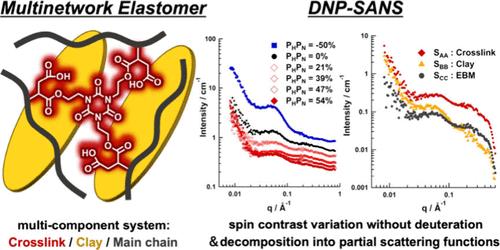Small-angle Neutron Scattering Combined with Spin Polarization Contrast Variation Elucidates Structural Details of Multinetwork Elastomer
IF 5.2
1区 化学
Q1 POLYMER SCIENCE
引用次数: 0
Abstract
To elucidate the complexity of cross-linking in multinetwork elastomers (MNEs), we employed small-angle neutron scattering combined with dynamic nuclear polarization (DNP-SANS). MNEs were designed as thermoplastic elastomers with three kinds of cross-linking consisting of hydrogen, covalent, and clay plane bonds. DNP-SANS profiles were obtained with continuously changing scattering contrasts for MNEs with different cross-link densities. We clearly recognize the three matching points in scattering intensity, originating from pairs of cross-linking groups, clay, or main chains. DNP-SANS profiles were decomposed into three partial scattering functions for self-terms of cross-linking groups clay and their cross-terms. The self-term exhibits a scattering maximum due to the interplane distance of clay, which changes with the cross-link density. The cross-term between clay and cross-link was obtained as negative, indicating that the cross-linking domains are tightly correlated, localizing on the clay surface. The results indicate that DNP-SANS is a crucial technique for obtaining structural details of MNE cross-linking without chemical deuteration.

小角中子散射结合自旋极化对比变化揭示了多网络弹性体的结构细节
为了阐明多网络弹性体(MNEs)交联的复杂性,我们采用了小角中子散射结合动态核极化(DNP-SANS)的方法。MNEs被设计成热塑性弹性体,具有氢键、共价键和粘土平面键三种交联方式。在不同交联密度的MNEs中,通过连续变化的散射对比获得DNP-SANS曲线。我们清楚地认识到散射强度的三个匹配点,来自交联基团对,粘土或主链。将DNP-SANS剖面分解为交联基团粘土自项及其交叉项的三个部分散射函数。自项表现出最大的散射,这是由于粘土的面间距离,随着交联密度的变化而变化。粘土与交联之间的交项为负,表明交联域紧密相关,定位于粘土表面。结果表明,DNP-SANS是一种无需化学氘化而获得MNE交联结构细节的关键技术。
本文章由计算机程序翻译,如有差异,请以英文原文为准。
求助全文
约1分钟内获得全文
求助全文
来源期刊

Macromolecules
工程技术-高分子科学
CiteScore
9.30
自引率
16.40%
发文量
942
审稿时长
2 months
期刊介绍:
Macromolecules publishes original, fundamental, and impactful research on all aspects of polymer science. Topics of interest include synthesis (e.g., controlled polymerizations, polymerization catalysis, post polymerization modification, new monomer structures and polymer architectures, and polymerization mechanisms/kinetics analysis); phase behavior, thermodynamics, dynamic, and ordering/disordering phenomena (e.g., self-assembly, gelation, crystallization, solution/melt/solid-state characteristics); structure and properties (e.g., mechanical and rheological properties, surface/interfacial characteristics, electronic and transport properties); new state of the art characterization (e.g., spectroscopy, scattering, microscopy, rheology), simulation (e.g., Monte Carlo, molecular dynamics, multi-scale/coarse-grained modeling), and theoretical methods. Renewable/sustainable polymers, polymer networks, responsive polymers, electro-, magneto- and opto-active macromolecules, inorganic polymers, charge-transporting polymers (ion-containing, semiconducting, and conducting), nanostructured polymers, and polymer composites are also of interest. Typical papers published in Macromolecules showcase important and innovative concepts, experimental methods/observations, and theoretical/computational approaches that demonstrate a fundamental advance in the understanding of polymers.
 求助内容:
求助内容: 应助结果提醒方式:
应助结果提醒方式:


